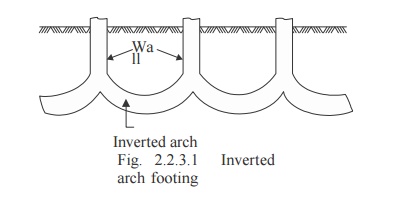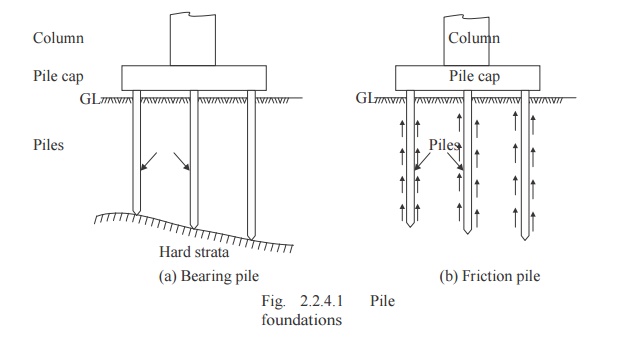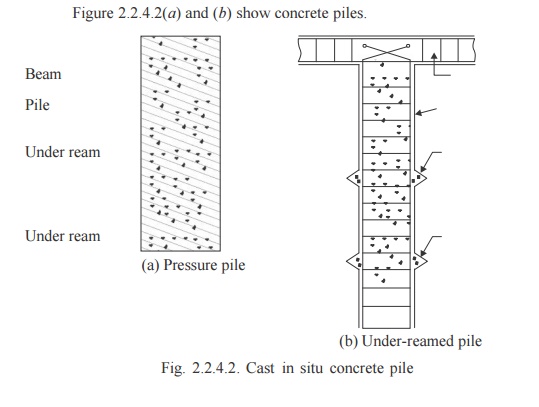Chapter: Civil Engineering : Building Components and Structures
Arch foundation and Pile foundations
Arch foundation
Inverted arch foundations are provided in the
places where the SBC of the soil is very poor and the load of the structure is
through walls. In such cases inverted arches are constructed between the walls.
End walls should be sufficiently thick and strong to withstand the outward
horizontal thrust due to arch action. The outer walls may be provided with
buttress walls to strengthen them. Figure 2.2.3.1 shows a typical inverted arch
footing.

Pile foundations
These foundations are known as deep foundations.
A pile is a slender column made of wood, concrete or steel. A pile is either
driven into the soil or formed in situ by excavating a hole and then filling it
with concrete. A group of piles are driven to the required depth and are capped
with R.C.C. slab, over which super structure is built. The pile transfer the
load to soil by friction or by direct bearing, in the latter case, piles being
taken up to hard strata. This type of foundations is used when top soil is not
capable of taking the load of the structure even at 3–4 m depth.

Pile foundations
are classified according to the materials used and also on the nature of load
transfer.
Classification According to Materials Used:
Piles may be classified as:
(a) Timber
piles (b) Concrete piles (c) Steel piles and
(d) Composite piles.
(a) Timber
piles: Circular seasoned wood can be used as piles.
Their diameter may vary from 200 mm to 400 mm. Similarly square piles of
sizes 200 mm to 400 mm are also used. The length of timber pile should not be
more than 20 times its lateral dimension. The bottom of the pile is sharpened
and is provided with iron shoe, so that it can be driven in the ground easily
by hammering. These piles should be always kept below water table; otherwise
alternating wet and dry condition cause the decay. These piles are cheap and
can be easily driven rapidly. The main disadvantage is their load carrying
capacity is low and are likely to be damaged during driving in the soil.
(b) Concrete
piles: These piles may be further classified as precast
piles and cast in situ piles. Precast piles are reinforced with
steel and are manufactured in factories. The cross-section diameter/dimension
varies from 200 mm to 500 mm. Square, circular and octagonal sections are
commonly used. The length of piles may be up to 20 m. They are provided with
steel shoe at the lowest end. These piles can carry fairly large loads. These
piles are highly resistant to biological and chemical actions of the soil. The
disadvantage of these piles is they need more time to manufacture and are heavy
to handle.
Figure 2.2.4.2(a) and (b) show
concrete piles.

Fig. 2.2.4.2. Cast in situ concrete pile
Cast in situ
concrete piles are formed first by boring the holes
in the soil and then concreting them. Concreting is usually made
using casing tubes. If the hole is filled with only plain concrete it is
pressure pile. The load carrying capacity of the piles may be increased by
providing enlarged base.
The reinforcement caging may be
inserted in the bored holes and to increase load carrying capacity one or two
under reams may be formed. After that concreting may be carried out. Such piles
are known as under reamed piles. These piles are provided at regular interval
of 2 to 4 m and capping beam is provided over them.
(c) Steel Piles: A steel pile may be a rolled steel I sections, tubes or
fabricated in the form of box. These piles are mostly used as bearing
piles since surface available for friction is less and also the coefficient of
friction is less. If tubes are used the soil inside the tube is driven out by
compressed air and concrete is filled. These piles are very useful for driving
close to existing structures since they disturb the soil least.
(d) Composite Piles: Composite piles may be of concrete and timber or of concrete and
steel. Wooden piles should not be subjected to alternating wet and dry
conditions. Hence they are preferred for the portion below water table. The
portion above water table are built with cast in situ concrete piles.
If the required length of steel
piles is less than the depth of pile, many times upper portions are built with
concrete. Thus steel and concrete composite piles are sometimes used.
Classification of Piles According to
Load Transfer:
According to the load transfer to
the soil piles may be classified as
(a) Bearing
piles and (b) Friction piles.
Bearing piles rest
on hard strata and transfer the load by bearing. Such piles are preferred.
These piles are used if the hard strata are available at reasonable depth.
Friction piles transfer the load to the soil by
the friction between soil and the pile. Such piles are used if hard strata are
not available to a considerable depth. The friction developed is to be properly
assessed before deciding the length of the pile. The surface of such piles is
made rough to increase the skin friction so that required length of pile is
reduced.
Related Topics